Greetings, fellow cat enthusiasts! Today, I want to delve into a fascinating topic that has puzzled cat owners for centuries: cat humping. Have you ever wondered why your furry feline friend engages in this peculiar behavior? Well, you’re not alone!
Cats humping, also known as cats mating, is a complex behavior rooted in their innate reproductive instincts. While it may seem puzzling, there are actually various reasons why cats hump, and understanding these motives can help us better comprehend our feline companions.
In this article, I will explore the reasons behind cats humping while kneading, the connection between humping and kneading, the potential benefits and drawbacks of this behavior, and how to address and manage humping in cats. So, let’s embark on this journey together and unravel the mystery behind why cats hump!
Key Takeaways:
- Cats humping while kneading is a normal behavior rooted in their reproductive instincts.
- Humping can be a means of communication, establishing security, marking territory, or releasing pent-up energy.
- Cats may hump while kneading to express contentment, mark their owner or things with their scent, or in response to stress or anxiety.
- Humping can have potential risks and drawbacks, including overstimulation and potential harm to the bond between cat and owner.
- Positive reinforcement training, increased playtime, and creating a stable environment can help manage and reduce humping behavior in cats.
Is It Normal For My Cat To Hump While Kneading?
It is completely normal for a cat to hump while kneading. This behavior is a part of their natural instincts and is seen in both male and female cats. Cats may hump while kneading for a variety of reasons, including marking their territory, showing dominance, or expressing their sexual arousal. It is important for cat owners to understand that this behavior is a normal part of feline behavior and should not be cause for concern.
When cats hump while kneading, it can start as early as 6-8 weeks old for non-sexual reasons and around 5 months old for sexual reasons. The average age for cats to reach sexual maturity and start humping is around 5-6 months. However, it is important to note that humping while kneading is not always related to sexual behavior. Cats may engage in this behavior to communicate various emotions such as contentment, security, or stress.
In order to better understand why your cat is humping while kneading, it is important to observe their overall behavior and any changes in their environment. If you notice any signs of stress or anxiety in your cat, it may be a contributing factor to their humping behavior. Providing a stable and enriching environment for your cat, along with regular playtime and mental stimulation, can help alleviate any stress or anxiety that may be causing them to engage in this behavior.
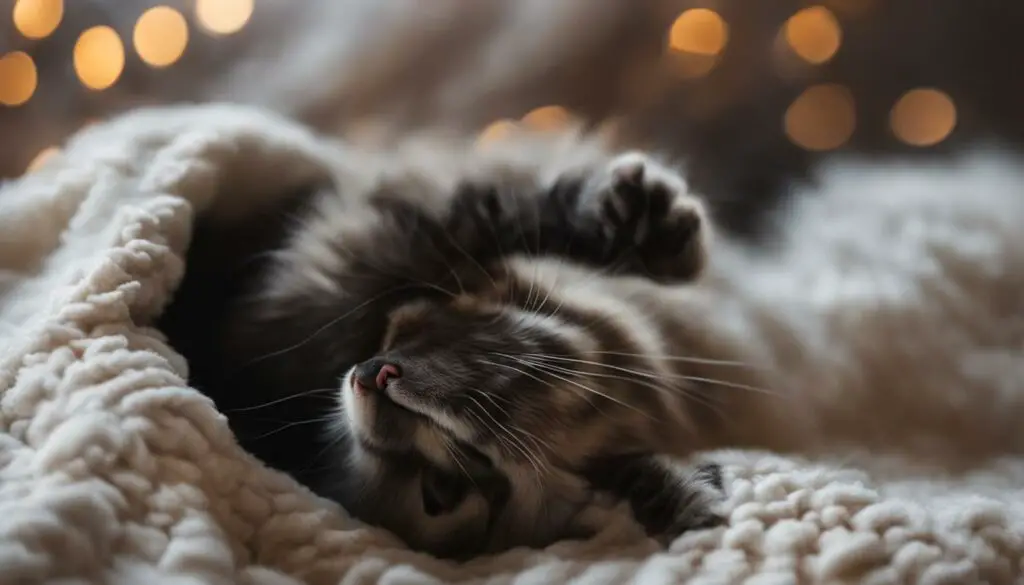
In summary, humping while kneading is a normal behavior for cats. It can be a way for them to communicate various emotions, establish their territory, or express their sexual arousal. Understanding the reasons behind this behavior can help cat owners better address their cat’s needs and provide a more enriching environment. If you have any concerns about your cat’s behavior, it is always a good idea to consult with a veterinarian for guidance.
The Connection Between Humping and Kneading
Kneading and humping are closely related behaviors in cats. They are both forms of communication. When cats knead, they express affection and comfort. It is a behavior commonly observed in kittens when they nurse, as they knead their mother’s belly to stimulate milk flow. As cats grow, kneading continues to be a way for them to express contentment and security. While kneading involves rhythmic pushing and pulling motions with their paws, humping can occur simultaneously or separately.
Humping, on the other hand, can serve various purposes for cats. It can be a way to assert dominance and mark territory. By humping objects or other animals, cats communicate their presence and establish their ownership. Humping can also be a response to stress or anxiety, allowing cats to release pent-up emotions and cope with their surroundings. It is important to note that humping and kneading can be independent behaviors, but they can also be combined as part of a cat’s communication repertoire.
By engaging in both kneading and humping, cats are able to communicate strong emotions and establish their place in their environment. These behaviors are instinctual and innate to cats, and while they may seem unusual to us humans, they are a natural part of feline behavior. Understanding the connection between humping and kneading can help us better comprehend our cats’ needs and emotions, fostering a deeper bond between human and feline companions.
| Behavior | Purpose |
|---|---|
| Kneading | Expressing affection and comfort |
| Humping | Asserting dominance, marking territory, releasing stress or anxiety |
Through kneading and humping, cats have developed a unique way of communicating. These behaviors should be understood within the context of feline society and instincts. While it is important to provide appropriate outlets for cats’ energy and address any underlying stressors, it is equally essential to respect and accept these behaviors as a normal part of our feline companions’ lives.
Why Does My Cat Hump While Kneading?
There are several reasons why your cat may hump while kneading. One of the main reasons is to communicate contentment and happiness. When your cat humps while kneading, it’s their way of showing that they are enjoying something or someone. It’s a sign that they feel safe and secure in their environment.
Another reason why cats hump while kneading is to mark their territory with their scent. By rubbing against objects or their owners while humping, cats are leaving their scent behind as a way to establish ownership. It’s a natural behavior that helps them feel more secure in their surroundings.
Humping while kneading can also be a way for cats to release pent-up energy. Cats are highly active animals, and sometimes they need an outlet to let go of their excess energy. By humping while kneading, they are engaging in physical activity and releasing that built-up energy.
| Reasons for Cat Humping While Kneading | Explanation |
|---|---|
| Communication of Contentment | Cats hump while kneading to show that they are happy and content in their environment. |
| Establishing Security | Humping while kneading helps cats feel more secure by marking their territory with their scent. |
| Marking with Scent | By humping and rubbing against objects or their owners, cats are leaving their scent behind to establish ownership. |
| Releasing Pent-Up Energy | Cats hump while kneading as a way to engage in physical activity and release excess energy. |
| Stress and Anxiety in Cats | In certain cases, humping while kneading can be a response to stress or anxiety in cats. |
If you notice your cat humping while kneading excessively or in response to stressful situations, it’s important to address their underlying stress or anxiety. Providing a calm and stable environment, along with plenty of mental and physical stimulation, can help reduce humping behavior caused by stress. If the behavior continues to be problematic, consulting with a veterinarian or a professional animal behaviorist can provide further guidance and support.
Potential Risks and Drawbacks of Cat Humping While Kneading
While cat humping while kneading can be a common behavior, it can also have potential risks and drawbacks that owners should be aware of. Overstimulation during humping can sometimes lead to aggressive behavior, which can result in potential injury to both the cat and the owner. Cats may scratch or bite during the humping process, especially if they become too excited or rough. This can cause discomfort or even break the skin, resulting in scratches or bites.
Humping behavior can also harm the bond between the cat and the owner. If the owner responds to humping with physical punishment or negative reinforcement, it can create a negative association and strain the relationship between the two. It’s essential for owners to approach any unwanted humping behavior with patience and positive reinforcement, redirecting the cat’s attention to alternative activities.
“Overstimulation during humping can sometimes lead to aggressive behavior, which can result in potential injury to both the cat and the owner.”
Creating a safe environment and setting boundaries for the cat can help minimize the risks associated with humping behavior. Providing the cat with appropriate toys and playtime can help them release excess energy, reducing the likelihood of humping. Additionally, consulting with a veterinarian or a professional animal behaviorist can provide further guidance on how to manage and address humping behavior in cats.
Potential Risks and Drawbacks of Cat Humping While Kneading:
| Risks | Drawbacks |
|---|---|
| Overstimulation during humping can lead to aggressive behavior. | Cats may scratch or bite during humping, causing potential injury. |
| Humping behavior can harm the bond between the cat and owner. | Responding with physical punishment can create negative associations. |
Understanding the potential risks and drawbacks of cat humping behavior is crucial for any cat owner. By providing appropriate outlets for energy, setting boundaries, and responding with positive reinforcement, owners can help manage and reduce humping behavior in their cats.
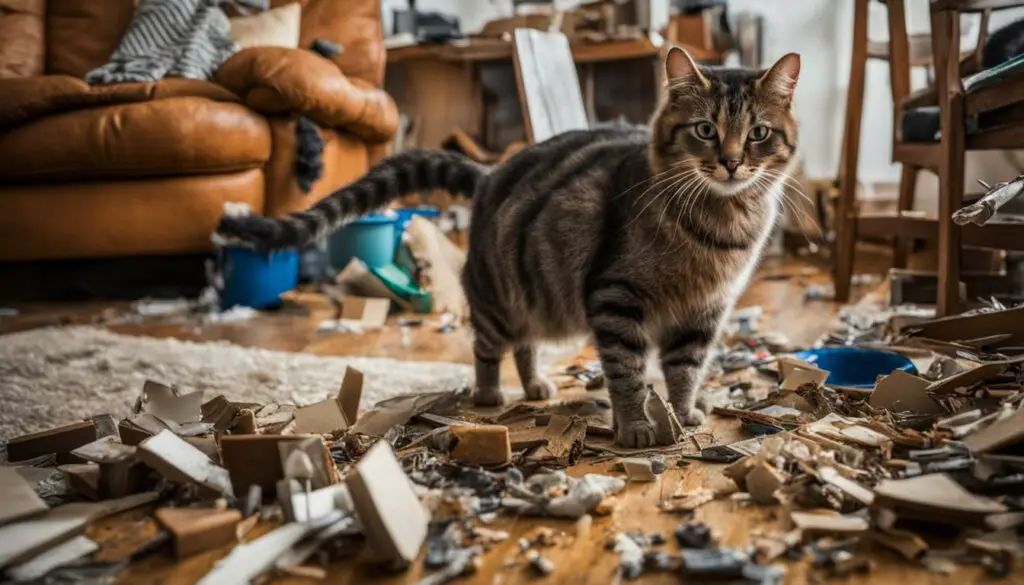
Note: The image above illustrates the potential risks associated with cat humping behavior.
Potential Benefits of Humping and Kneading in Cats
While cat humping while kneading can have drawbacks, it can also provide some benefits. One of the benefits of humping is stress release. Just like humans, cats can experience stress, and humping can serve as a way for them to release tension and decompress. It can be a form of physical activity that helps them feel more relaxed and at ease.
Humping while kneading can also be a way for cats to release pent-up energy. Cats are naturally active animals, and if they don’t have enough outlets for their energy, they may become restless or exhibit unwanted behaviors. Humping while kneading allows them to engage in a physical activity that helps them burn off excess energy, keeping them physically and mentally stimulated.
Additionally, humping while kneading can contribute to better sleep for cats. Cats often engage in kneading behavior as a means of self-soothing, and humping can enhance that soothing effect. By engaging in humping while kneading, cats may experience a sense of comfort and security that helps them relax and achieve a more restful sleep.
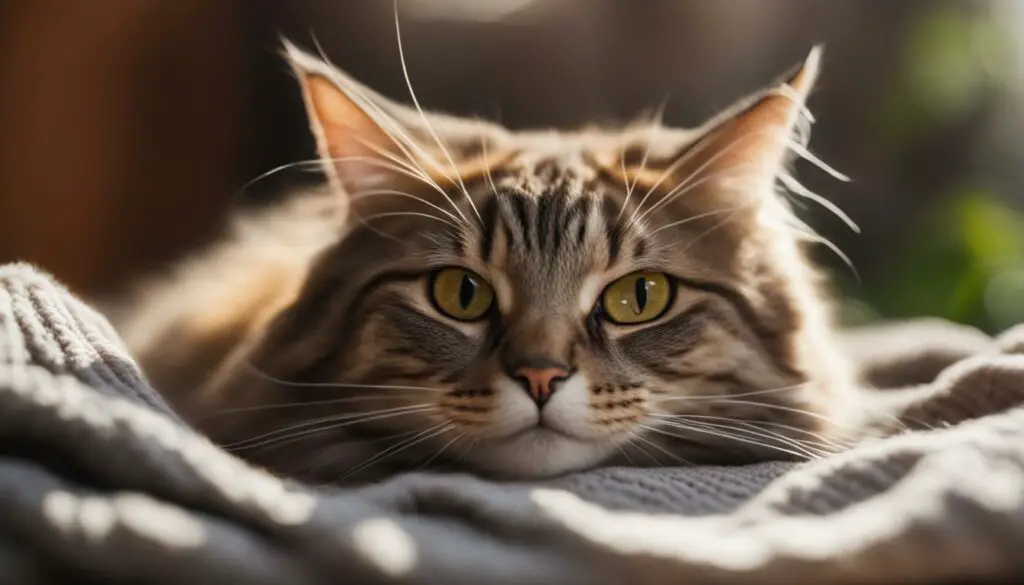
In summary, while cat humping while kneading may have its drawbacks, such as overstimulation or potential injury, it can also offer some benefits. Cats can release stress, burn off energy, and experience better sleep through the act of humping while kneading. It’s important for cat owners to understand and monitor their cat’s humping behavior to ensure it remains within a healthy and safe range.
How to Stop Your Cat from Humping While Kneading
If you’re wondering how to stop your cat from humping while kneading, it’s important to approach the situation with positive reinforcement and without physical punishment. Training can play a crucial role in redirecting this behavior and providing alternative outlets for your cat’s energy. By increasing playtime and providing appropriate toys, you can help your cat burn off excess energy and reduce the likelihood of humping while kneading.
Creating a routine and ensuring a stable environment are also essential in addressing this behavior. Cats thrive on consistency, so establishing a daily routine can help alleviate stress and anxiety that may contribute to humping. Providing your cat with a designated space where they feel safe and secure can also help reduce the need to hump while kneading.
Remember, patience is key when trying to stop your cat from humping while kneading. It may take time for them to unlearn this behavior, so consistency in training and providing appropriate outlets for their energy are essential. Consult with a veterinarian or animal behaviorist for additional guidance and support if needed.
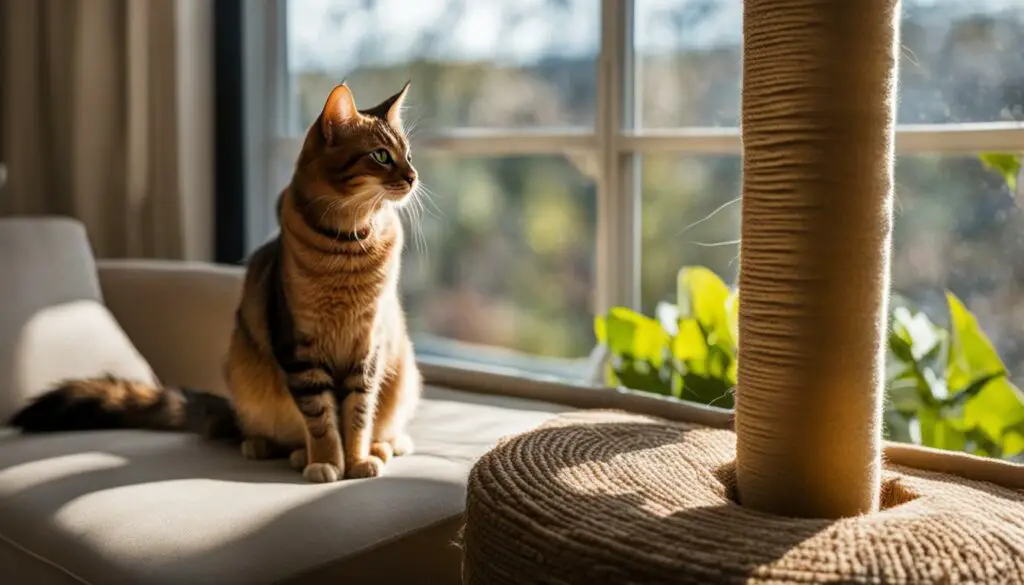
Training Tips:
- Use positive reinforcement techniques such as treats and praise to reward your cat for desired behaviors.
- Redirect their attention to appropriate toys or scratching posts when they start humping while kneading.
- Increase interactive playtime sessions to help your cat burn off excess energy.
- Provide mental stimulation through puzzle toys or food-dispensing toys to keep your cat engaged and occupied.
Creating a Routine:
- Establish a consistent feeding schedule to help regulate your cat’s energy levels.
- Designate specific playtime sessions throughout the day to provide structured physical activity.
- Create a calm and comfortable environment for your cat by providing hiding spots, cozy beds, and vertical spaces such as cat trees.
- Maintain a stable routine and avoid sudden changes in your cat’s environment or daily routine.
Summary:
Stopping your cat from humping while kneading requires a combination of positive reinforcement, training, and creating a stable environment. By increasing playtime, redirecting their attention, and providing mental stimulation, you can help your cat find alternative outlets for their energy. Consistency and patience are key, and consulting with a professional can provide additional guidance.
Understanding Cat Humping Behavior
When it comes to cat humping behavior, there are a few key factors at play. One of the main reasons why cats hump is to assert dominance. It’s a way for them to mark their territory and show their ownership. Additionally, humping can be a manifestation of affection. Cats may engage in this behavior as a form of bonding with their owners or other animals in the household.
Territorial behavior also plays a role in cat humping. Cats have a strong instinct to protect their territory, and humping can be a way for them to establish their dominance and secure their space. It’s important to understand that humping behavior in cats is not always sexual in nature. It can be driven by a variety of motivations, including establishing dominance, showing affection, or marking territory.
While cat humping behavior is often considered normal, it’s important to rule out any underlying medical issues that may be contributing to this behavior. In some cases, humping can be a sign of an infection or urinary tract blockage. If you notice any changes in your cat’s humping behavior or if it becomes excessive, it’s best to consult a veterinarian to ensure there are no underlying health concerns.
| Reasons for Cat Humping | Explanation |
|---|---|
| Dominance and Affection | Cats may hump to assert dominance or show affection towards their owners or other animals. |
| Territorial Behavior | Humping can be a way for cats to establish their territory and mark their ownership. |
| Underlying Medical Issues | In some cases, humping behavior may be a symptom of an underlying infection or urinary tract blockage. |
Understanding the motivations behind cat humping behavior can help owners respond appropriately. It’s important to provide a stable and enriched environment for your cat, ensuring they have plenty of mental and physical stimulation. If you have any concerns about your cat’s humping behavior, consult a veterinarian for guidance and support.
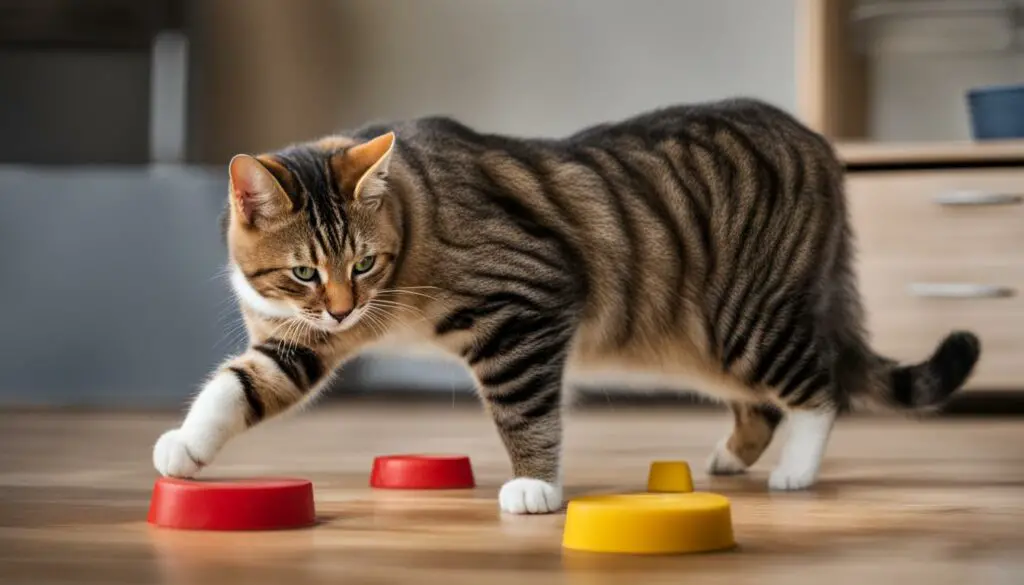
Is Your Cat Humping? What You Should Know
If you’ve noticed your cat engaging in humping behavior, it’s essential to understand that there can be underlying reasons for this behavior. Cat humping can be a symptom of various issues, including stress, anxiety, boredom, or frustration. Changes in your cat’s environment or routine can trigger humping behavior as they try to cope with their emotions.
Stress and anxiety can manifest in different ways for cats, and humping may be one way for them to release pent-up energy or express their emotions. Boredom and frustration can also lead to humping behavior as your cat seeks stimulation or tries to alleviate their feelings of restlessness.
If you notice your cat humping, it’s essential to observe their overall behavior for other signs of stress or anxiety. These may include excessive grooming, changes in appetite, aggression, or hiding. Consulting with a veterinarian can help determine if there are any underlying medical issues contributing to your cat’s humping behavior.
“Cat humping can be a symptom of various underlying issues such as stress, anxiety, boredom, or frustration.”
| Common Causes of Cat Humping | Signs of Stress, Anxiety, Boredom, or Frustration in Cats |
|---|---|
| Stressful or new environments | Excessive grooming |
| Changes in routine | Loss of appetite |
| Lack of mental or physical stimulation | Increased aggression |
| Underlying medical issues | Withdrawal or hiding |
To address humping behavior in cats, it’s important to provide adequate mental and physical stimulation. Engage your cat in playtime to help burn off excess energy and provide interactive toys to keep them entertained. Establishing a routine and maintaining a stable environment can also help reduce feelings of stress and anxiety.
Remember that it’s crucial to approach humping behavior with positive reinforcement and without physical punishment. Training can help redirect the behavior and provide alternative outlets for your cat’s energy. By understanding and addressing the underlying causes of humping, you can help your cat lead a happier and more contented life.
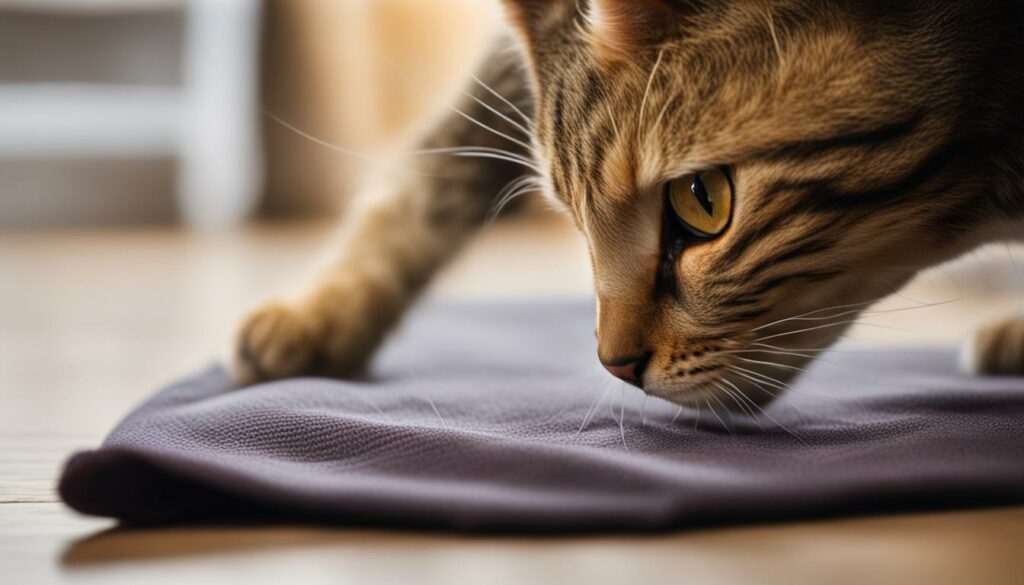
Why Does My Cat Hump My Leg?
When your cat humps your leg, it can be a display of dominance and affection. Cats have a natural instinct to mark their territory, and by humping your leg, they are asserting their ownership. It’s important to understand that this behavior is not necessarily a sign of sexual arousal, but rather a way for your cat to communicate their social standing and feelings towards you.
Additionally, humping can also be a form of stress relief for cats. They may engage in this behavior when they are feeling anxious or overwhelmed. However, it’s crucial to rule out any underlying medical issues that could be causing the humping behavior. If you notice any other unusual symptoms or behavior changes in your cat, it’s recommended to consult with a veterinarian for a thorough examination.
Remember, cats are complex creatures with their own unique personalities and motivations. While leg humping can be a normal behavior for some cats, it’s essential to provide them with appropriate outlets for their energy and establish a stable and enriching environment. Understanding your cat’s behavior and providing them with love, attention, and mental stimulation can help address leg humping and maintain a strong bond between you and your feline companion.
Table: Common Reasons for Cat Humping
| Reasons | Description |
|---|---|
| Dominance and Affection | Cats may hump to assert dominance and mark their territory. It can also be a display of affection towards their owner. |
| Stress and Anxiety | Humping can serve as a stress release for cats in response to environmental changes or other sources of anxiety. |
| Underlying Medical Issues | Some cats may hump due to urinary tract infections or other medical conditions. It’s important to consult with a veterinarian to rule out any health concerns. |
Understanding the reasons behind your cat’s leg humping behavior can help you address it effectively and provide them with the care and support they need.
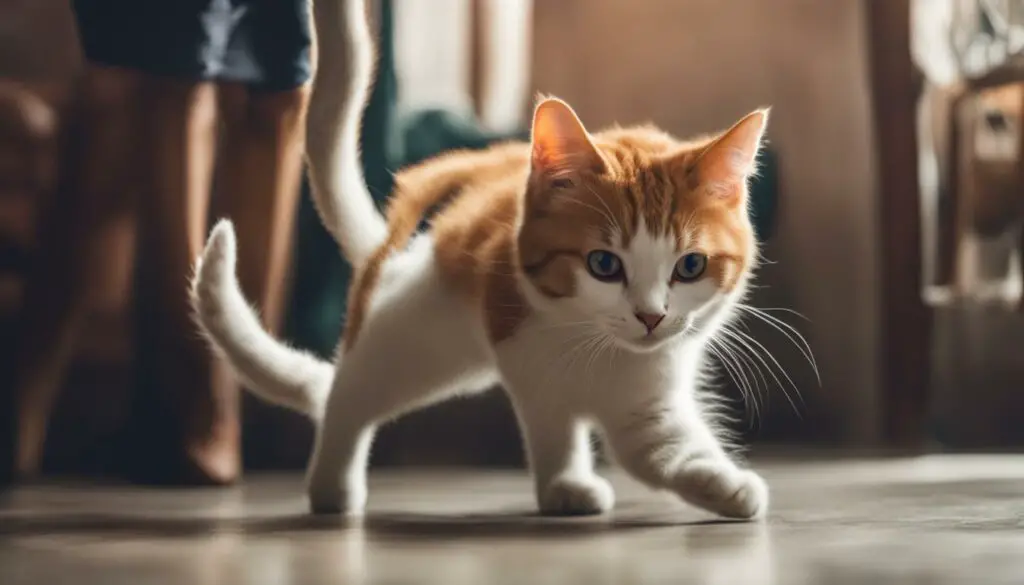
Why Does My Cat Hump My Leg Even Though He’s Neutered?
Neutering is a common procedure performed on male cats to prevent them from reproducing and to reduce certain behaviors associated with sexual maturity. However, it’s important to note that neutered cats can still exhibit humping behavior, even though their reproductive capabilities have been removed.
One reason why neutered cats may hump is due to residual hormones in their system. It takes time for these hormones to dissipate completely, and during this transition period, some cats may still display mating behaviors, including humping. The duration and intensity of humping behavior can vary from cat to cat, but it usually decreases over time as the hormones continue to diminish.
It’s also possible for neutered cats to hump due to underlying medical issues. In some cases, humping can be a sign of discomfort or pain caused by conditions such as urinary tract infections or inflammation. If you notice that your neutered cat is humping excessively or persistently, it’s best to consult with a veterinarian to rule out any potential medical concerns.
Overall, while humping behavior in neutered cats may seem puzzling, it’s important to remember that it can be influenced by both hormonal factors and potential medical issues. By monitoring your cat’s behavior and seeking veterinary advice when necessary, you can ensure their overall well-being and happiness.
| Neutered Cats Humping: | Hormones: | Underlying Medical Issues: |
|---|---|---|
| Neutered cats can still exhibit humping behavior. | Residual hormones in their system can contribute to humping. | Humping can indicate underlying medical issues such as urinary tract infections. |
| Humping behavior may decrease over time as hormones dissipate. | Consult with a veterinarian to rule out any potential medical concerns. | Monitor your cat’s behavior and seek appropriate veterinary advice. |
“Neutering is a common procedure performed on male cats to prevent them from reproducing and to reduce certain behaviors associated with sexual maturity.”
Why Does My Cat Hump My Leg at Night?
It can be quite surprising and even amusing when your cat decides to hump your leg at night. This behavior is often driven by a combination of playfulness, attention-seeking behavior, and marking territory. Cats are naturally nocturnal creatures, and their energy levels tend to be higher during the night. Humping your leg can be a way for them to engage in interactive play and seek your attention.
Additionally, cats have scent glands in their paws, and kneading and humping can serve as a way to mark you as their territory. It’s their way of saying, “This human belongs to me!” While this behavior may seem strange to us, it’s important to remember that cats have unique instincts and behaviors that may not always align with our expectations.
To address this behavior, it’s essential to provide your cat with appropriate outlets for play and mental stimulation during the day. Engage in interactive play sessions using toys to help burn off excess energy. Establishing a regular playtime routine can also help promote better sleep at night and reduce attention-seeking behaviors like leg humping. Creating a stable and secure environment for your cat can also help alleviate the need for territorial marking.
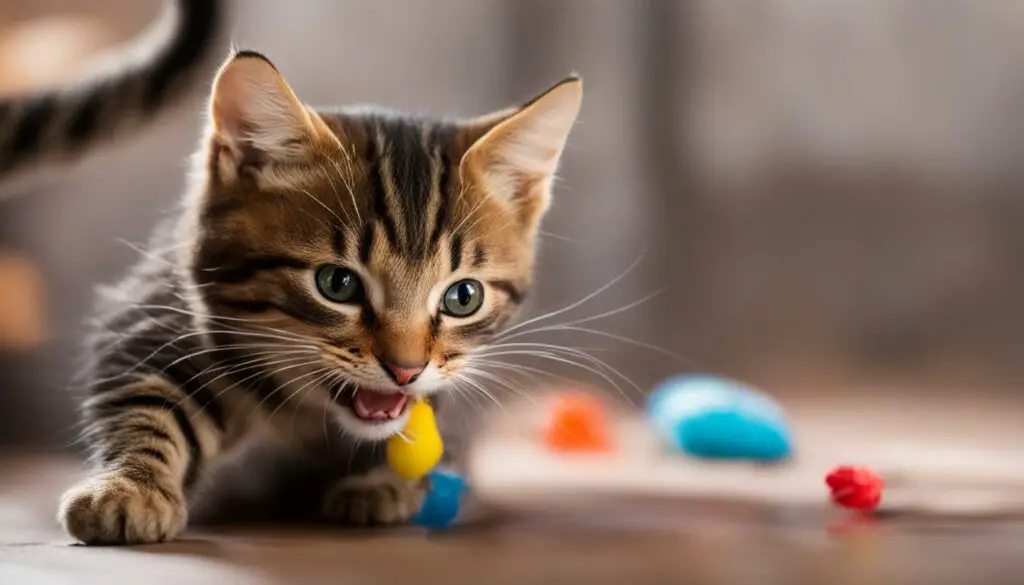
Here are some tips to discourage leg humping at night:
- Provide stimulating toys and playtime during the day to exhaust their energy
- Create a comfortable sleeping environment for your cat with a cozy bed or designated sleeping area
- Establish a regular routine for feeding, playtime, and sleep to help your cat feel secure
- Consider using pheromone sprays or diffusers to create a calm and stress-free environment
Remember, it’s important to respond to your cat’s behavior with patience and understanding. Punishment or negative reinforcement can harm the bond between you and your cat. If you have concerns about your cat’s humping behavior or if it becomes excessive or aggressive, it’s always best to consult with a veterinarian or a professional animal behaviorist for guidance.
Conclusion
In conclusion, understanding cat humping behavior is essential for cat owners. It is a normal behavior that cats engage in for various reasons, including communication, contentment, and stress. By recognizing the motivations behind cat humping, owners can effectively address this behavior.
To manage cat humping behavior, positive reinforcement and training are key. Redirecting the behavior and providing alternative outlets for energy can help prevent excessive humping. Increasing playtime and creating a stable routine can also reduce the likelihood of humping.
It’s important to remember that cat humping behavior can be a symptom of underlying issues, such as stress, anxiety, or boredom. If the humping behavior persists or is accompanied by other signs of distress, consulting a veterinarian is recommended.
By actively addressing cat humping behavior and providing appropriate mental and physical stimulation, owners can create a harmonious environment for their feline companions.
FAQ
Is it normal for my cat to hump while kneading?
Yes, humping while kneading is a normal behavior for cats. It can be a way for them to express contentment and security.
What is the connection between humping and kneading in cats?
Kneading and humping are closely related behaviors in cats. They both serve as forms of communication, with kneading expressing affection and comfort, and humping indicating various emotions such as dominance, stress, or sexual arousal.
Why does my cat hump while kneading?
Cats may hump while kneading to communicate contentment, establish a sense of security, mark their owner or things with their scent, or to release pent-up energy. It can also be a sign of stress or anxiety.
What are the potential risks and drawbacks of cat humping while kneading?
Overstimulation during humping can lead to aggressive behavior, and cats can injure themselves or scratch or bite their owners. Physical punishment can harm the bond between the cat and owner.
Are there any potential benefits of humping and kneading in cats?
Yes, humping can serve as a stress release for cats and help them release pent-up energy. It can also help them feel calm and secure, leading to better sleep.
How can I stop my cat from humping while kneading?
Stopping cat humping should be approached with positive reinforcement and without physical punishment. Training, increasing playtime, and creating a routine can help redirect the behavior and provide alternative outlets for energy.
What should I know about cat humping behavior?
Cat humping can be driven by various factors, including dominance and affection. It can also be a symptom of underlying medical issues or stress, anxiety, boredom, or frustration.
Why does my cat hump my leg?
Cat humping your leg can be a sign of dominance and affection. It can be a way for them to mark you as their territory or show their ownership.
Why does my neutered cat still hump?
Neutered male cats can still exhibit humping behavior as it takes time for hormones to leave their bodies after neutering. It can also be a result of underlying medical issues.
Why does my cat hump my leg at night?
Cat humping your leg at night can be a sign of playfulness and a desire for attention. It can also be a way for them to mark their territory.








